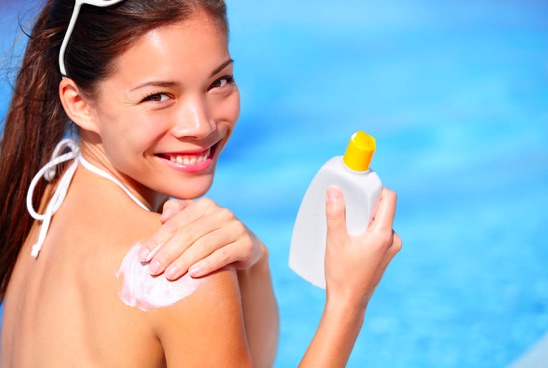|
Sunscreen and the right clothes can shield your skin from the sun's harmful rays -- but 
only if you avoid these three common errors.
If the only thing you look for in a sunscreen is a certain SPF, your skin and wallet stand to get burned.
Sun protection that is both effective and affordable does exist. But if you don’t know what to look for in a sunscreen or how to get the most protection out of it, you will likely waste your money and possibly increase your odds of developing skin cancer.
Shielding your skin from the sun’s harmful rays need not be complicated, though. Just avoid these three big mistakes:
1. Failing to Use a “broad spectrum SPF” sunscreen
The term “sun protection factor,” or “SPF,” refers to a sunscreen’s level of protection from ultraviolet B radiation, or UVB rays. The American Academy of Dermatology also describes UVB rays as “burning rays” because they are the primary cause of sunburn.
But the sun also emits ultraviolet A radiation, or UVA rays. The academy also describes these as “aging rays” because they can prematurely age skin, leading to wrinkles and age spots.
Both UVA and UVB rays can lead to skin cancer, too, so you need sunscreen that protects against both. Such products are often described as offering “broad spectrum” protection.
Look for sunscreens with the phrase “broad spectrum SPF” followed by an SPF number on the front of the product. Under federal law, manufacturers can use that phrase only on products that pass a broad-spectrum testing procedure.
If you expect to swim or sweat while wearing sunscreen, also look for the word “water-resistant” followed by either “(40 minutes)” or “(80 minutes)” on the front of the bottle. By law, this phrase can be used only on products that pass a testing procedure.
If you don’t want to trust the government with your skin, check out the results of sunscreen product testing conducted by independent nonprofits like Consumer Reports or the Skin Cancer Foundation.
2. Applying sunscreen incorrectly
How you apply sunscreen impacts its effectiveness.
Start by shaking the bottle, even if the directions don’t say to. This helps distribute the active ingredients — which provide the sun protection — throughout the product, Consumer Reports says.
Next, experts advise applying sunscreen 15 to 30 minutes before going into the sun.
As for the quantity of sunscreen, the American Academy of Dermatology recommends using 1 ounce of lotion — enough to fill a shot glass — to cover all of the exposed areas of the body. You can adjust that amount depending on your body size.
Consumer Reports offers another rule of thumb: 1 teaspoon per area of the body — such as the face, neck or each arm.
Don’t forget areas like your ears, hands, lips and the tops of your feet. For your lips, check out the two dozen lip balms and other lip productswith sunscreen that have earned a Seal of Recommendation from the Skin Cancer Foundation.
Lastly, reapply sunscreen about every two hours, and after swimming or sweating.
3. Wearing the wrong clothing
To get more sun protection than a sunscreen can offer, toss on a hat or some clothing.
Some textiles have been rated with an ultraviolet protection factor, or UPF, which indicates how much UV radiation can penetrate the fabric.
The Skin Cancer Foundation considers a UPF rating of 30 to 49 “very good protection” and a UPF of 50 or more “excellent protection.”
In general, light-colored, lightweight and loosely woven fabrics offer less sun protection than darker and heavier fabrics. According to the foundation:
“That white T-shirt you slip on at the beach when you feel your skin burning provides only moderate protection from sunburn, with an average ultraviolet protection factor (UPF) of 7. At the other end of the spectrum, a long-sleeved dark denim shirt offers an estimated UPF of 1,700 — which amounts to a complete sun block.”
A good rule of thumb: If you can see through a fabric when you hold it up to the light, UV rays can penetrate it.
Posted Friday, June 15 2018 11:00 AM
Tags : 3 Mistakes That Can Make Your Sun Protection Worthless
|